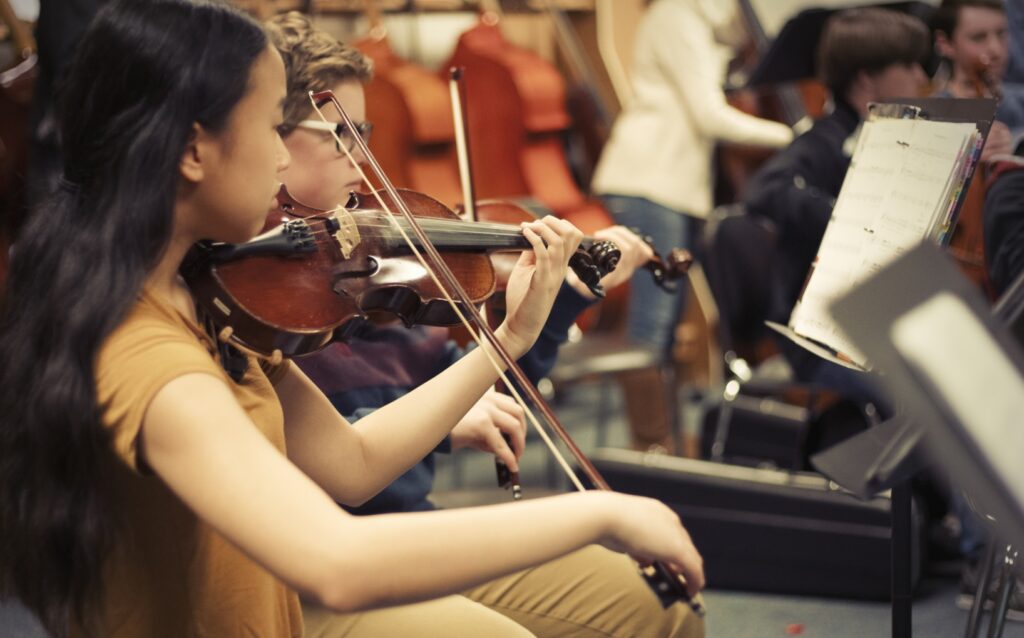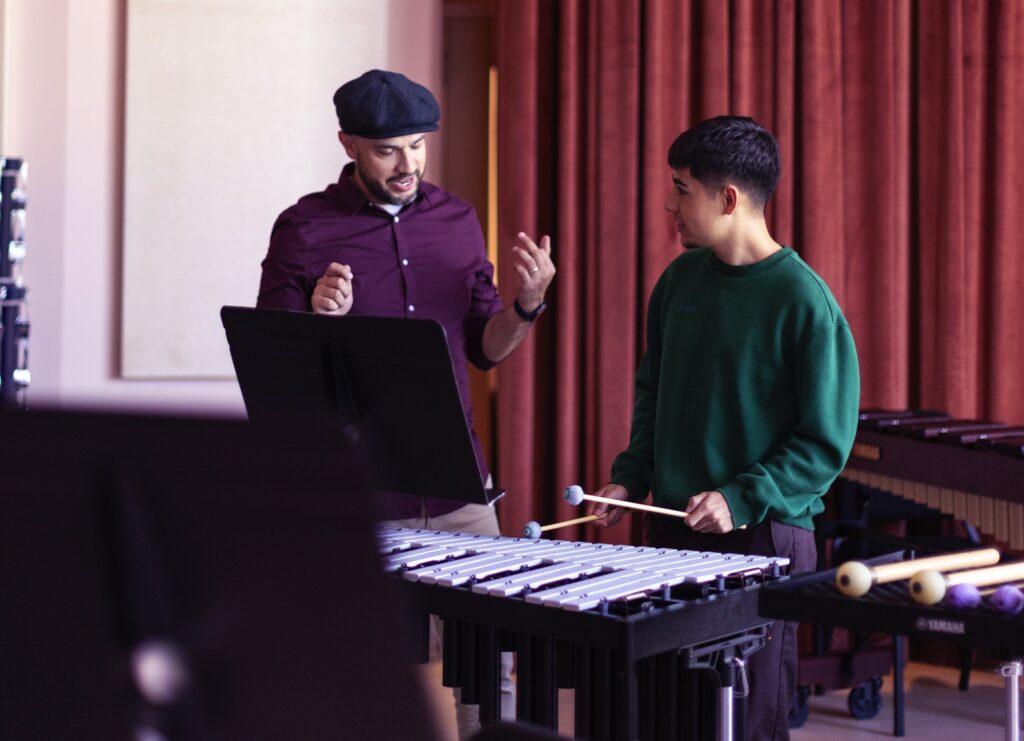Teach Composition to Older Beginners Using Kodály Philosophies
The Kodály Concept, which focuses on singing and physical movement, is a great way to help high schoolers connect to music.
Teaching high school students who have never had any formal music training the language of music can leave a profound impact on not only their love for music but also contribute to their cognitive development and improve their literacy skills. One of the best ways to do this is by creating a course on music composition that can be available to anyone. You can accomplish it all with limited resources.
In my music composition classes, I incorporate the Kodály Concept, a student-centered, sequential teaching philosophy inspired by Hungarian composer and educator Zoltán Kodály (1882-1967) that focuses on learning music through singing and extensive physical movement. In this way, the learning environment is not a torture but a joy, says Kodály, for students as they experience music through three different modes: kinesthetic, auditory and visual.
CLICK ON THE LINKS BELOW TO READ ABOUT MY FOUR TIPS:
1. START WITH THE BODY
2. USE MUSIC STUDENTS KNOW
3. TREAT MUSIC COMPOSITION LIKE A LANGUAGE CLASS
4. INCORPORATE TECHNOLOGY
THE YAMAHA EDUCATOR NEWSLETTER: Join to receive a round-up of our latest articles and programs!
1. Start with the Body
 Regardless of your students’ age, music learning should start with the body. One of the six principles of the Kodály philosophy — the body is an instrument — may be used as the basis for learning. It may or may not come as a surprise that many high school students have a hard time keeping a steady beat. If students are lacking the heart of the music, how can we teach them to be music literate in the absence of steady beat?
Regardless of your students’ age, music learning should start with the body. One of the six principles of the Kodály philosophy — the body is an instrument — may be used as the basis for learning. It may or may not come as a surprise that many high school students have a hard time keeping a steady beat. If students are lacking the heart of the music, how can we teach them to be music literate in the absence of steady beat?
Rhythmic activities that require students to move their bodies and experience music standing up will dramatically transform their musical skills and competencies. Some may think of singing games and beat-passing activities as rudimentary, but when you add the element of competition, you will never see a group of high school students so focused to not drop the beat … or else they are out!
I have used basketballs and drumsticks (click on the links to the see the videos) to teach students about keeping a steady beat. Plus, activities like these get students away from their computer screens, out of their chairs and focused on strengthening their collaboration and relationship-building skills — a prime opportunity for the educator to make intentional connections with Social-Emotional Learning competencies in their arts-based learning environment.
2. Use Music Students Know
The best way to teach concepts and skills of composition is through music students know and love. Another principle of the Kodály philosophy — using folk music or music familiar to students — may be seen as one of the earliest practices of culturally responsive teaching. The folk music of students today is popular music. We have a responsibility as music educators to bring the music of our students into the classroom and embed it within the curriculum. The latest rap, pop, hip-hop, EDM song or whatever is trending on TikTok (like sea shanties for a brief moment in time) all have a place in the music room. Use these sources to teach certain concepts like rhythm patterns, intervals or melodic contour.
Moving from the known (folk) to the unknown (world musics) may strengthen students’ musicianship and provide deeper connections to music in their daily lives. Identifying similarities of stepwise motion in a popular song to Beethoven’s “Ode to Joy” may provide a more holistic experience to music learning while giving some credibility to the old, dead white guys. It may be equally important to show our students how “old” songs like “The Blue Danube” by Johann Strauss often reappear in popular media like Nickelodeon’s SpongeBob SquarePants. Or how the simplicity of Strauss’s three-pitch motive can be like the simplicity of the main motive in “Happy” by Pharrell Williams, also created primarily with three different pitches.
3. Treat Music Composition Like a Language Class
Another one of the Kodály principles is that music literacy is equal to language literacy. Every child has a right to be music literate, which serves as the beginning of their musical understanding. Kodály cautioned that a lack of musical understanding may be “worse than illiteracy.” Reading, writing, hearing and playing music must all be incorporated into a music composition course.
Begin with basic rhythmic patterns, typically starting with playing and listening, then moving on to reading and writing. Repeat the same process with short melodic phrases. Using body percussion or chair drumming (playing the seat of the chair as the snare and the back of the chair as the hi hat) along with a popular song is a quick way into practicing rhythmic concepts before students create their own. If keyboards are available to your class, have them play short, known melodies to strengthen their aural and reading skills.
 Throughout all these activities, embed music theory so that students can ground their knowledge. Use numbers to count rhythms according to the meter so older students can quickly determine the difference between time signatures. Incorporate relay races or other challenge-type games to identify notes written on the grand staff to ensure that students are accountable for their musical knowledge. If you ever want to get an entire room of high school students completely silent and focused on their listening skills, create a game to correctly identify the intervals of step, skip and leap.
Throughout all these activities, embed music theory so that students can ground their knowledge. Use numbers to count rhythms according to the meter so older students can quickly determine the difference between time signatures. Incorporate relay races or other challenge-type games to identify notes written on the grand staff to ensure that students are accountable for their musical knowledge. If you ever want to get an entire room of high school students completely silent and focused on their listening skills, create a game to correctly identify the intervals of step, skip and leap.
And like all other languages, the cultural relevance of musical terms is important. Just like the Spanish words “jalapeño” and “quesadilla” are pronounced in a specific way, so should the Italian musical terms of “dal segno,” “fortissimo,” “accelerando” and “crescendo.”
4. Incorporate Technology
Today’s music composition class is also a technology class. Although technology is not one of the principles of the Kodály philosophy, music being at the core of the curriculum is. Technology is what will allow our music students to become more globally aware and competent with 21st-century skills.
Most public high schools provide Chromebooks to students via 1:1 or have technology available for student use in the school building. The power these devices have to transform and enhance the learning environment is often taken for granted because they are in our students’ hands every day. But if students never receive the opportunity to explore the world of creating music on their Chromebooks, what good do they serve beyond the functions of email and Google? Using a browser-based notation software will not come intuitively to most students. You may recall typing programs that you used as a child that taught you how to type and increase your words per minute. The same can be true for music notation programs.
Begin with short activities that allow students to recreate music they know and love into a notation software. Arranging a basic melody in stepwise motion with quarter notes and eighth notes is deceptively simple. Knowing how to change note values and pitches with ease will be paramount in your students’ success in your music composition course. Continue plugging in known and analyzed short musical pieces into the notation software until students are confident and comfortable. Also, the shortcuts of cut, copy and paste are often built into the notation software, so students may continue practicing needed computer skills while learning about musical form and theory.
Achieve Music Literacy
At the end of the day, remember that a course in music composition is not meant to develop the next Mozart or Scott Joplin. Focusing on developing complete musical pieces may be too much for some students. Creating a short musical jingle for a popular brand may be the culminating project for some students, while others will be able to create fully through-composed pieces.
Yes, you may have stand-out students who will reach great heights, but the majority will simply gain a deeper musical understanding and have the possibility of becoming musically literate. And what a gift that is!
















